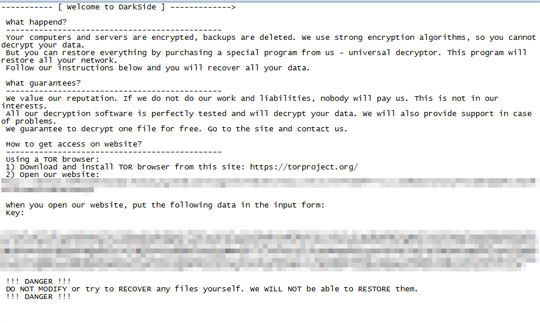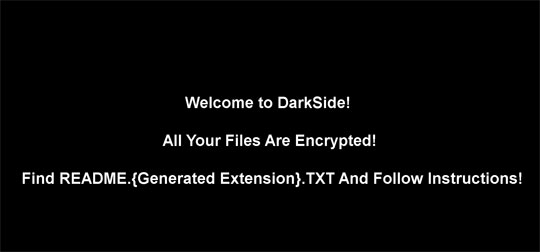Ransom.Win32.DARKSIDE.FAIO
Win32:DangerousSig [Trj] (AVAST)
Windows


Threat Type: Ransomware
Destructiveness: No
Encrypted: Yes
In the wild: Yes
OVERVIEW
This Ransomware arrives on a system as a file dropped by other malware or as a file downloaded unknowingly by users when visiting malicious sites.
However, as of this writing, the said sites are inaccessible.
It drops files as ransom note. It avoids encrypting files with the following file extensions.
TECHNICAL DETAILS
Arrival Details
This Ransomware arrives on a system as a file dropped by other malware or as a file downloaded unknowingly by users when visiting malicious sites.
Installation
This Ransomware drops the following files:
- %All Users Profile%\{Generated Extension}.ico → Icon for encrypted files.
- %All Users Profile%\{Generated Extension}.BMP → Used as wallpaper.
(Note: %All Users Profile% is the common user's profile folder, which is usually C:\Documents and Settings\All Users on Windows 2000(32-bit), XP, and Server 2003(32-bit), or C:\ProgramData on Windows Vista, 7, 8, 8.1, 2008(64-bit), 2012(64-bit) and 10(64-bit). )
It adds the following processes:
- {Malware Directory}\{Malware Filename} -work worker{Number} job{Number}-{4-Digit Number} → For every drive that it will encrypt.
It adds the following mutexes to ensure that only one of its copies runs at any one time:
- Global\{32-Hex Characters generated from Machine GUID}
Other System Modifications
This Ransomware adds the following registry entries as part of its installation routine:
HKEY_LOCAL_MACHINE\SOFTWARE\Classes\
.{Generated Extension}
(Default) = {Generated Extension}
HKEY_LOCAL_MACHINE\SOFTWARE\Classes\
{Generated Extension}\DefaultIcon
(Default) = %All Users Profile%\{Generated Extension}.ico
It changes the desktop wallpaper by modifying the following registry entries:
HKEY_USERS\{USER SID}\Control Panel\
Desktop
Wallpaper = %All Users Profile%\{Generated Extension}.BMP
HKEY_USERS\{USER SID}\Control Panel\
Desktop
WallpaperStyle = 10
It sets the system's desktop wallpaper to the following image:
Process Termination
This Ransomware terminates the following services if found on the affected system:
- vss
- sql
- svc$
- memtas
- mepocs
- sophos
- veeam
- backup
- GxVss
- GxBlr
- GxFWD
- GxCVD
- GxCIMgr
It terminates the following processes if found running in the affected system's memory:
- sql
- oracle
- ocssd
- dbsnmp
- synctime
- agntsvc
- isqlplussvc
- xfssvccon
- mydesktopservice
- ocautoupds
- encsvc
- firefox
- tbirdconfig
- mydesktopqos
- ocomm
- dbeng50
- sqbcoreservice
- excel
- infopath
- msaccess
- mspub
- onenote
- outlook
- powerpnt
- steam
- thebat
- thunderbird
- visio
- winword
- wordpad
- notepad
Information Theft
This Ransomware gathers the following data:
- Username
- Computer Name
- Domain Name
- OS Information (Type, Version, Architecture)
- System Language
- Drives Information (Drive Names, Drive Space)
Stolen Information
This Ransomware sends the gathered information via HTTP POST to the following URL:
- bar{BLOCKED}ees.com
Other Details
This Ransomware adds the following registry keys:
HKEY_LOCAL_MACHINE\SOFTWARE\Classes\
.{Generated Extension}
HKEY_LOCAL_MACHINE\SOFTWARE\Classes\
{Generated Extension}
HKEY_LOCAL_MACHINE\SOFTWARE\Classes\
{Generated Extension}\DefaultIcon
It does the following:
- It checks computer's language and will terminate itself if any of the following language is detected:
- Arabic
- Armenian
- Azerbaijani
- Belarusian
- Georgian
- Kazakh
- Kyrgyz
- Romanian
- Russian
- Tajik
- Tatar
- Turkmen
- Ukranian
- Uzbek
- It checks if it is running with a privilege level that is on SYSTEM level. If it is not, it will do the following:
- If it is running on a non-administrator account and the os version is Windows 7 or above it will use the Elevated COM Object UAC Bypass technique to execute an instance of itself with SYSTEM level privilege.
- If it is running on an administrator account it would add the following service then start and use the service to execute an instance of itself with SYSTEM level privilege. The service is deleted after it is used.
- Service Name: .{Generated Extension}
- Binary Pathname: {Malware Directory}\{Malware Filename}
- It searches for files to encrypt in fixed drives, removable drives, and network resources.
- It empties the recycle bin.
- It deletes shadow copies.
However, as of this writing, the said sites are inaccessible.
Ransomware Routine
This Ransomware avoids encrypting files with the following strings in their file name:
- autorun.inf
- boot.ini
- bootfont.bin
- bootsect.bak
- desktop.ini
- iconcache.db
- ntldr
- ntuser.dat
- ntuser.dat.log
- ntuser.ini
- thumbs.db
- README.{Generated Extension}.TXT
It avoids encrypting files with the following strings in their file path:
- $recycle.bin
- config.msi
- $windows.~bt
- $windows.~ws
- windows
- appdata
- application data
- boot
- mozilla
- program files
- program files (x86)
- programdata
- system volume information
- tor browser
- windows.old
- intel
- msocache
- perflogs
- x64dbg
- public
- all users
- default
It appends the following extension to the file name of the encrypted files:
- .{8-Hex Characters generated from Machine GUID}
It drops the following file(s) as ransom note:
- {Encrypted Directory}\README.{Generated Extension}.TXT

It avoids encrypting files with the following file extensions:
- .386
- .adv
- .ani
- .bat
- .bin
- .cab
- .cmd
- .com
- .cpl
- .cur
- .deskthemepack
- .diagcab
- .diagcfg
- .diagpkg
- .dll
- .drv
- .exe
- .hlp
- .icl
- .icns
- .ico
- .ics
- .idx
- .ldf
- .lnk
- .mod
- .mpa
- .msc
- .msp
- .msstyles
- .msu
- .nls
- .nomedia
- .ocx
- .prf
- .ps1
- .rom
- .rtp
- .scr
- .shs
- .spl
- .sys
- .theme
- .themepack
- .wpx
- .lock
- .key
- .hta
- .msi
- .pdb
- .{Generated Extension}
SOLUTION
Step 1
Trend Micro Predictive Machine Learning detects and blocks malware at the first sign of its existence, before it executes on your system. When enabled, your Trend Micro product detects this malware under the following machine learning name:
- Troj.Win32.TRX.XXPE50FFF043
Step 2
Before doing any scans, Windows 7, Windows 8, Windows 8.1, and Windows 10 users must disable System Restore to allow full scanning of their computers.
Step 3
Note that not all files, folders, and registry keys and entries are installed on your computer during this malware's/spyware's/grayware's execution. This may be due to incomplete installation or other operating system conditions. If you do not find the same files/folders/registry information, please proceed to the next step.
Step 4
Restart in Safe Mode
Step 5
Identify and terminate files detected as Ransom.Win32.DARKSIDE.FAIO
- Windows Task Manager may not display all running processes. In this case, please use a third-party process viewer, preferably Process Explorer, to terminate the malware/grayware/spyware file. You may download the said tool here.
- If the detected file is displayed in either Windows Task Manager or Process Explorer but you cannot delete it, restart your computer in safe mode. To do this, refer to this link for the complete steps.
- If the detected file is not displayed in either Windows Task Manager or Process Explorer, continue doing the next steps.
Step 6
Delete this registry key
Important: Editing the Windows Registry incorrectly can lead to irreversible system malfunction. Please do this step only if you know how or you can ask assistance from your system administrator. Else, check this Microsoft article first before modifying your computer's registry.
- In HKEY_LOCAL_MACHINE\SOFTWARE\Classes\.{Generated Extension}
- In HKEY_LOCAL_MACHINE\SOFTWARE\Classes\{Generated Extension}
Step 7
Search and delete this file
- %All Users Profile%\{Random characters}.ico
- {Encrypted Directory}\README.{Generated Extension}.TXT
- %All Users Profile%\{Generated Extension}.BMP
Step 8
Reset your Desktop properties
Step 9
Restart in normal mode and scan your computer with your Trend Micro product for files detected as Ransom.Win32.DARKSIDE.FAIO. If the detected files have already been cleaned, deleted, or quarantined by your Trend Micro product, no further step is required. You may opt to simply delete the quarantined files. Please check this Knowledge Base page for more information.
Step 10
Restore encrypted files from backup.
Did this description help? Tell us how we did.




